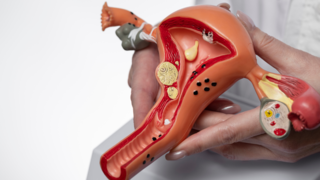In this article:
About 20 per cent of babies born to individuals with polyhydramnios have some form of congenital anomaly. There are no specific maternal age factors linked to these conditions, so they can occur in any pregnancy.
Understanding these processes helps your healthcare professional determine the cause of abnormal fluid levels and plan appropriate care.
How Polyhydramnios and Oligohydramnios Develop
The amount of amniotic fluid in your womb is carefully balanced by your baby’s physiological processes. In the second half of pregnancy, amniotic fluid is primarily composed of foetal urine, with a near-term baby producing between 500 and 1200 ml of urine daily.Your baby also swallows amniotic fluid, typically between 210 and 790 ml per day, which helps regulate fluid levels. If something disrupts this balance, such as a blockage in your baby’s gastrointestinal tract or an inability to swallow, it can lead to polyhydramnios. This is when too much amniotic fluid builds up in the womb.
On the other hand, oligohydramnios often results from a rupture of the membranes, causing fluid to leak out. It can also occur if your baby isn’t producing enough urine due to urinary tract issues or if there’s a blockage preventing urine flow.
Causes of Polyhydramnios
Polyhydramnios can result from different causes. Some of these causes are well-known, while others are still not fully understood.- In twin pregnancies, a condition called twin-to-twin transfusion syndrome can lead to polyhydramnios in one twin (the recipient) and oligohydramnios in the other (the donor).
- Foetal anomalies like oesophageal atresia, tracheal agenesis, or intestinal blockages, which prevent your baby from swallowing fluid properly.
- Central nervous system disorders or neuromuscular conditions that impair swallowing.
- Congenital heart rhythm problems are linked to hydrops, foetal-to-maternal haemorrhage, or infections like parvovirus.
- Poorly controlled maternal diabetes is another common cause.
- Chromosomal abnormalities, such as trisomy 21, 18, or 13, or foetal akinesia syndrome, where swallowing is absent.
Causes of Oligohydramnios
Oligohydramnios has its own set of causes related to fluid production or loss. Here are some common causes:- The most common cause is premature rupture of membranes (PROM), where amniotic fluid leaks out chronically. This can also lead to chorioamnionitis, a maternal infection occurring in 21 to 74 per cent of such cases. It increases risks for your baby, including lung and neurological complications or even respiratory failure.
- Foetal urinary tract problems, such as renal agenesis (absent kidneys), polycystic kidneys, or blockages like posterior urethral valves, can prevent adequate urine production.
- Placental insufficiency, seen in conditions like pregnancy-induced hypertension, maternal diabetes, or pregnancies extending beyond 42 weeks, can also reduce amniotic fluid.
- Certain medications that might increase the risk of low amniotic fluid are prostaglandin synthase inhibitors or angiotensin-converting enzyme inhibitors.
Diagnosis and Evaluation of Polyhydramnios and Oligohydramnios
When polyhydramnios or oligohydramnios is identified, a thorough evaluation of the infant is recommended based on postnatal findings. This evaluation may include:- Chromosome testing to identify genetic abnormalities.
- Testing for congenital infections.
- Ultrasonography of the genitourinary tract to assess for structural anomalies.
- Radiologic evaluation of the gastrointestinal tract to detect obstructions or malformations.
- Electrocardiography and echocardiography to evaluate heart function, if indicated.
- Histologic examination of the placenta to determine the underlying causes of amniotic fluid abnormalities.
Laboratory Tests
Lab tests are crucial for checking foetal lung maturity and investigating underlying causes of polyhydramnios or oligohydramnios. These can be assessed in the following ways:- Amniotic fluid lamellar body count.
- Lecithin-sphingomyelin (L:S) ratio.
- Phosphatidylglycerol (PG) concentration.
Polyhydramnios
Perform glucose tolerance testing for mothers with suspected type 2 diabetes mellitus.If foetal hydrops is present, it’s important to investigate immunologic causes and foetal infections. This includes screening for maternal antibodies such as D, C, Kell, Duffy, and Kidd antigens. Testing for infections like cytomegalovirus (CMV), toxoplasmosis, syphilis, and parvovirus B19 is also necessary.
The investigation should include the following studies:
- The Venereal Disease Research Laboratories (VDRL) test for syphilis.
- Immunoglobulin G (IgG) and IgM titers for rubella, CMV, toxoplasmosis, and parvovirus.
- Polymerase chain reaction (PCR) to detect congenital viruses in amniotic fluid.
- Kleihauer-Betke test to assess foetal-maternal haemorrhage.
- Haemoglobin Bart testing for alpha-thalassemia.
- Foetal karyotyping to check for trisomy 21, 13, and 18.
Oligohydramnios
Doctors confirm or rule out the possibility of premature rupture of membranes. Next, maternal factors are examined, such as:- Substance abuse or medications
- Pregnancy-induced hypertension or HELLP syndrome (red blood cell breakdown)
- Elevated blood pressure
- Proteinuria
- Elevated uric acid levels
- Increased liver function test results
- Low platelet count
Prenatal Ultrasound for Polyhydramnios
- Examine the baby’s anatomy for issues like a diaphragmatic hernia, lung masses, or the absence of the stomach bubble.
- Look for the double-bubble sign or a dilated duodenum.
- Test for foetal arrhythmias or malformations that may cause cardiac failure and hydrops.
- Measure abdominal circumference, as an enlargement could be linked to ascites or hydrops fetalis.
- Identify macrosomia.
- Anencephaly: Where a baby is born without parts of the brain and skull.
- Trisomy 18 (Edwards syndrome) or 21 (Down syndrome): These are genetic conditions caused by an extra chromosome.
- Muscular dystrophy: A group of diseases that cause muscle weakness and loss of muscle mass.
- Skeletal dysplasia: A group of disorders that affect the growth and development of bones and cartilage.
Prenatal Ultrasound for Oligohydramnios
- The amniotic fluid index (AFI) is checked regularly. If the AFI is less than 8 cm in the third trimester, oligohydramnios can be suspected. If the levels drop below 5 cm, it indicates significant oligohydramnios.
- Visualise foetal kidneys, collecting system, and bladder. Normal results may mean there’s long-term leakage of amniotic fluid or pregnancy-related high blood pressure.
- Assessing foetal growth helps identify placental insufficiency and intrauterine growth restriction if there is no premature rupture of the membranes.
Procedures to Manage Polyhydramnios and Oligohydramnios
Specific procedures may be employed to manage polyhydramnios or oligohydramnios and reduce associated risks.Polyhydramnios
- Reductive amniocentesis: It prolongs pregnancy in severe cases by reducing amniotic fluid volume. It also decreases the risks of preterm labour, PROM, umbilical cord prolapse, and placental abruption.
- Laser ablation of placental vessels: It is effective for twin-to-twin transfusion syndrome.
Oligohydramnios
- Transabdominal instillation of indigo carmine: Used to evaluate PROM.
- Transcervical amnioinfusion: Involves the instillation of isotonic sodium chloride solution during delivery. It reduces the risks of cord compression, foetal distress, and meconium aspiration. This procedure might also decrease the need for caesarean delivery.
FAQs on Polyhydramnios and Oligohydramnios
- Can oligohydramnios affect the baby?
Yes, low amniotic fluid can increase the risk of complications like premature birth, foetal distress, and growth restrictions. - How is polyhydramnios diagnosed?
Polyhydramnios is diagnosed through ultrasound imaging, which measures the amount of amniotic fluid.









